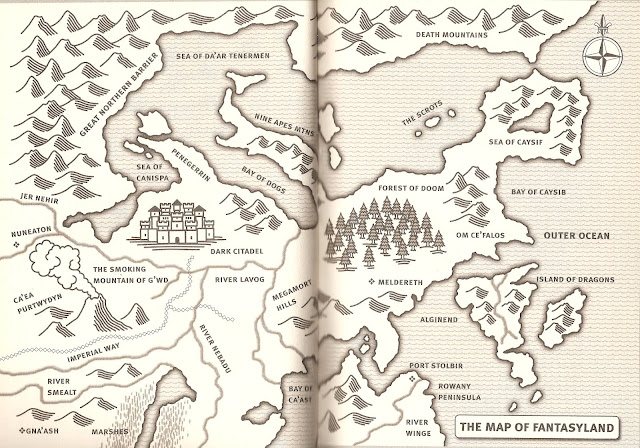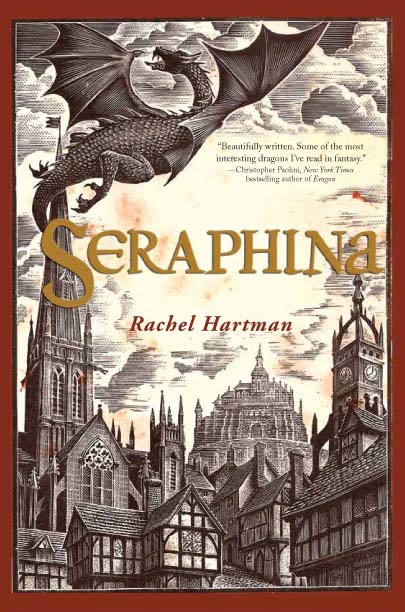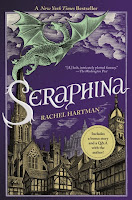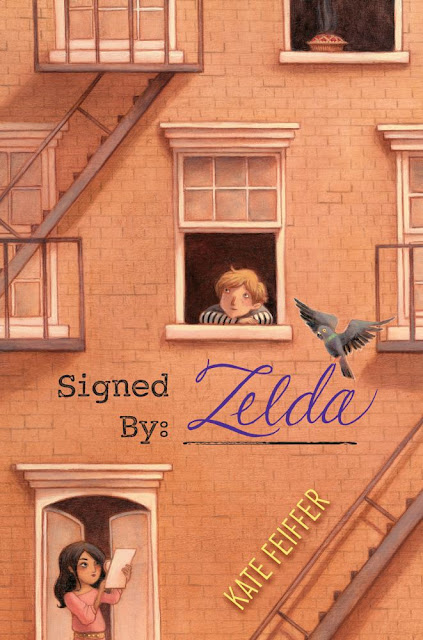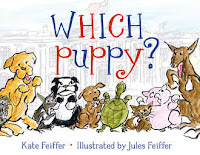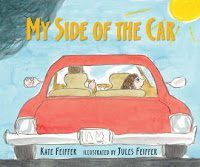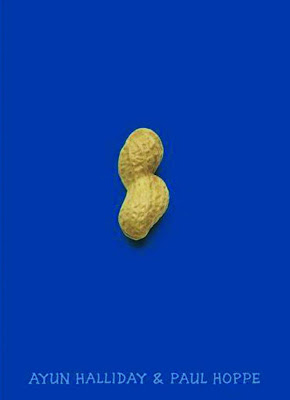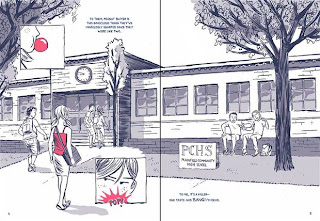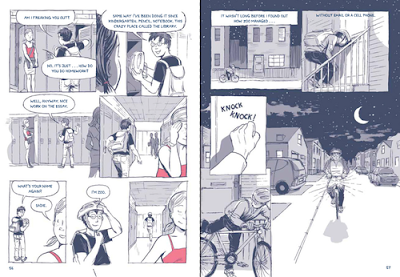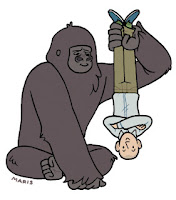
If you have been following my blog for a while, it's no secret that fantasy - kid's fantasy - is my favorite genre, and one that I really only began exploring in a post-Harry Potter world. There wasn't much fantasy when I was a kid in the late 70s and early 80s. Working as a children's bookseller beginning in 1995, it was easy to track the influence of JK Rowling's work on the world of children's literature when Harry Potter and the Sorcerer's Stone was released in the US in 1997. Even better, though, was the impetus it gave me to explore authors who had been writing for this genre all along that I had never heard of, like Brits Eva Ibottoson, Joan Aiken and Diana Wynne Jones, to name a few. And, while there are plenty of post-Potter Americans contributing amazing books to the genre of fantasy for kids and setting their stories squarely on American soil, there is just something about a work of fantasy by an author from the UK that feels more genuine than anything else - to me. Enchanted Glass is the penultimate book published by Diana Wynne Jones, in the US anyway, and I hope in this review to point out what makes her work unique and outstanding.
As she did in her Chrestomanci Series of books, which begins with Charmed Life, (check out my review of this book which includes more expansive information about all of Diana Wynne Jones's works) magic is a part of everyday life in the world that we know in Enchanted Glass. There is not a wardrobe that leads to a world of magic, but magic that exists side by side with the world we know or,e even better, is an integral, if sometimes secret, part of everyday life. When Enchanted Glass begins, Andrew Brandon Hope is driving from the university where he is a professor (no, not a professor, an academic, as he tells Mrs. Stock's deaf ears) to the small, nearby village of Melstone to visit his grandfather. When the ghost of his grandfather appears to him in the middle of the road, gesturing to a piece of paper in his hand and causing Andrew to run off the roa into a ditch. After the apparition disappears, Andrew uses magic to get his car out of the mud. Magic that is so simple and straightforward it almost doesn't even seem like magic the way Andrew performs it, as Jones describes it.
He thought of movements of sky and earth, time, and space. He though Einstein and skyhooks. He thought that the position of the wheel in the ditch was only a temporary and relative fact, untrue five minutes ago and untrue five minutes from now. He thought of the power and speed of that skid and repelling power of the ditch. He thought of gravity reversing itself. Then he knelt down with one hand on the grassy mud and the other on the wheel and pushed the two apart. Obediently, with some reluctant squelching and squeaking, the car moved out of the ditch and over the bank and bumped down the road.
This paragraph, which comes early on in the book - page 4 to be exact - makes me feel like I could perform the same feat if I could just corral my thoughts like Andrew. The scene ends with Andrew acknowledging that his grandfather would simply have "stood in the road and beckoned to get the same result," and he resolves to work at the practical side of magic with more dedication. Little does Andrew know what is to come.
Andrew not knowing much about magic is the central theme of Enchanted Glass. He inherits Melstone House, his grandfather's estate, and everything in it but, because of a rift between his grandfather, Jocelyn Brandon, and Andrew's mother, who viewed magic as unsavory and embarrassing, Jocelyn never got around to telling Andrew much about this part of his life when he was living or if he did, Andrew seems to have forgotten all of it. However, he two were very close and Andrew was allowed to spend summers with Jocelyn, giving him a certain level of familiarity with the estate. Besides the estate, Andrew comes to learn that he has inherited his grandfather's "field-of-care," or region of magical responsibility, although it is a long while before Andrew realizes the true responsibility that comes with this and the importance of his job. It seems there is deviousness at work, especially when it comes to the owner of the nearby estate of a Mr. O. Brown. Gradually, the reader, and eventually Andrew, realizes that nothing is what is seems in Melstone, or rather, there are two versions of everything. It takes the appearance of a boy named Aidan Cain, on the run from a dark force that began haunting him in London shortly after the death of his grandmother, to help turn things around for Andrew and everyone else in this story that is packed full of adults.
Jones has a way with subtle humor in Enchanted Glass, and the characters in this village and their summer fête are lovingly caricatured in this story that takes on glimmers of "A Midsummer Night's Dream" as the story unfolds. There is Mr. Stock, the gardener at Melstone House who, when he is angered (which is often) "gifts" the overgrown, often inedible, products of his prize-winning vegetable patch to Andrew. Then, there is the domineering, sour Mrs. Stock, no relation to Mr. Stock - a good "half the people in Melstone were called Stock" - who cooks Mr. Stock's vegetables for Andrew as punishment (cauliflower cheese being the most common) and insists on returning the furniture that Andrew rearranges to original positions when Andrew is away. Mrs. Stock enlists her nephew Shaun who, for lack of a better term, seems to be an idiot savant, to work for Andrew, thinking this might be further punishment for him. Add to this, Tarquin O'Connor, a retired jockey who lost a leg, and his lovely daughter Stashe (short for Eustacia), niece to Mr. Stock. Mr. Stock gets Stashe hired on by Andrew to sort out the affairs of the estate and ostensibly help him write his book.
There are as many skillfully woven plot threads in this story as there are panes in the enchanted glass of the title (see the UK cover below for a great visual.) As Andrew and Aidan, who is carries with him the fear of being returned to London and the foster care system at any moment, get to know each other and in turn, understand their magical talents, preparations for the summer fête are heatedly going on around them, their doubles arriving at Melstone House in greater numbers, all searching for a boy named Adam or Alan or Ethan, each one more menacing and familiar than the next. As Andrew and Aidan work improve their skills and determine the magical field of care, Mr. O. Brown (Oberon...) and his cronies work to get at Aidan, culminating in a spectacular, massive magical storm that converges on the fête, each villager displaying a magical trait of their own in an effort to fight off the King of the Fairies.
If this doesn't already sound drastically different from most works in this genre, consider this. As Marjorie Ingall wrote in her review two new works of fantasy for middle grade readers in the New York Times Book Review on May 10, 2013,
Want to write a middle-grade fantasy adventure series? It’s easy! First, conjure up a plucky, prickly team of three — children who have to learn to trust one another and work together. Make the stakes really high; saving the world is always good. Use lots of wisecracking humor. Ensure the parents are absent (dead, missing, away — you’ll figure it out). Invoke classic themes and figures from folklore and mythology, but don’t bother becoming slavishly wedded to them. Be sure to include an intellectually or physically butt-kicking girl.
Of all these common elements, Enchanted Glass has almost none. While Aidan's mother is dead and his grandmother has recently died, he is the lone child in a book filled with adults, save the teenaged Shaun. And, while there is no "intellectually or physically butt-kicking girl," Jones does make Stashe out to be lovely and tough and good for a fight when called on. There are classic themes from folklore and mythology and, more than seeming wedded to them, Jones seems interested in weaving them into everyday life and showing how something is always simmering just under the surface if we can only find the right angle at which to observe it, all will be revealed. Like looking at someone through a stained glass window, I suppose.
As she did in her Chrestomanci Series of books, which begins with Charmed Life, (check out my review of this book which includes more expansive information about all of Diana Wynne Jones's works) magic is a part of everyday life in the world that we know in Enchanted Glass. There is not a wardrobe that leads to a world of magic, but magic that exists side by side with the world we know or,e even better, is an integral, if sometimes secret, part of everyday life. When Enchanted Glass begins, Andrew Brandon Hope is driving from the university where he is a professor (no, not a professor, an academic, as he tells Mrs. Stock's deaf ears) to the small, nearby village of Melstone to visit his grandfather. When the ghost of his grandfather appears to him in the middle of the road, gesturing to a piece of paper in his hand and causing Andrew to run off the roa into a ditch. After the apparition disappears, Andrew uses magic to get his car out of the mud. Magic that is so simple and straightforward it almost doesn't even seem like magic the way Andrew performs it, as Jones describes it.
He thought of movements of sky and earth, time, and space. He though Einstein and skyhooks. He thought that the position of the wheel in the ditch was only a temporary and relative fact, untrue five minutes ago and untrue five minutes from now. He thought of the power and speed of that skid and repelling power of the ditch. He thought of gravity reversing itself. Then he knelt down with one hand on the grassy mud and the other on the wheel and pushed the two apart. Obediently, with some reluctant squelching and squeaking, the car moved out of the ditch and over the bank and bumped down the road.
This paragraph, which comes early on in the book - page 4 to be exact - makes me feel like I could perform the same feat if I could just corral my thoughts like Andrew. The scene ends with Andrew acknowledging that his grandfather would simply have "stood in the road and beckoned to get the same result," and he resolves to work at the practical side of magic with more dedication. Little does Andrew know what is to come.
Andrew not knowing much about magic is the central theme of Enchanted Glass. He inherits Melstone House, his grandfather's estate, and everything in it but, because of a rift between his grandfather, Jocelyn Brandon, and Andrew's mother, who viewed magic as unsavory and embarrassing, Jocelyn never got around to telling Andrew much about this part of his life when he was living or if he did, Andrew seems to have forgotten all of it. However, he two were very close and Andrew was allowed to spend summers with Jocelyn, giving him a certain level of familiarity with the estate. Besides the estate, Andrew comes to learn that he has inherited his grandfather's "field-of-care," or region of magical responsibility, although it is a long while before Andrew realizes the true responsibility that comes with this and the importance of his job. It seems there is deviousness at work, especially when it comes to the owner of the nearby estate of a Mr. O. Brown. Gradually, the reader, and eventually Andrew, realizes that nothing is what is seems in Melstone, or rather, there are two versions of everything. It takes the appearance of a boy named Aidan Cain, on the run from a dark force that began haunting him in London shortly after the death of his grandmother, to help turn things around for Andrew and everyone else in this story that is packed full of adults.
Jones has a way with subtle humor in Enchanted Glass, and the characters in this village and their summer fête are lovingly caricatured in this story that takes on glimmers of "A Midsummer Night's Dream" as the story unfolds. There is Mr. Stock, the gardener at Melstone House who, when he is angered (which is often) "gifts" the overgrown, often inedible, products of his prize-winning vegetable patch to Andrew. Then, there is the domineering, sour Mrs. Stock, no relation to Mr. Stock - a good "half the people in Melstone were called Stock" - who cooks Mr. Stock's vegetables for Andrew as punishment (cauliflower cheese being the most common) and insists on returning the furniture that Andrew rearranges to original positions when Andrew is away. Mrs. Stock enlists her nephew Shaun who, for lack of a better term, seems to be an idiot savant, to work for Andrew, thinking this might be further punishment for him. Add to this, Tarquin O'Connor, a retired jockey who lost a leg, and his lovely daughter Stashe (short for Eustacia), niece to Mr. Stock. Mr. Stock gets Stashe hired on by Andrew to sort out the affairs of the estate and ostensibly help him write his book.
There are as many skillfully woven plot threads in this story as there are panes in the enchanted glass of the title (see the UK cover below for a great visual.) As Andrew and Aidan, who is carries with him the fear of being returned to London and the foster care system at any moment, get to know each other and in turn, understand their magical talents, preparations for the summer fête are heatedly going on around them, their doubles arriving at Melstone House in greater numbers, all searching for a boy named Adam or Alan or Ethan, each one more menacing and familiar than the next. As Andrew and Aidan work improve their skills and determine the magical field of care, Mr. O. Brown (Oberon...) and his cronies work to get at Aidan, culminating in a spectacular, massive magical storm that converges on the fête, each villager displaying a magical trait of their own in an effort to fight off the King of the Fairies.
If this doesn't already sound drastically different from most works in this genre, consider this. As Marjorie Ingall wrote in her review two new works of fantasy for middle grade readers in the New York Times Book Review on May 10, 2013,
Want to write a middle-grade fantasy adventure series? It’s easy! First, conjure up a plucky, prickly team of three — children who have to learn to trust one another and work together. Make the stakes really high; saving the world is always good. Use lots of wisecracking humor. Ensure the parents are absent (dead, missing, away — you’ll figure it out). Invoke classic themes and figures from folklore and mythology, but don’t bother becoming slavishly wedded to them. Be sure to include an intellectually or physically butt-kicking girl.
Of all these common elements, Enchanted Glass has almost none. While Aidan's mother is dead and his grandmother has recently died, he is the lone child in a book filled with adults, save the teenaged Shaun. And, while there is no "intellectually or physically butt-kicking girl," Jones does make Stashe out to be lovely and tough and good for a fight when called on. There are classic themes from folklore and mythology and, more than seeming wedded to them, Jones seems interested in weaving them into everyday life and showing how something is always simmering just under the surface if we can only find the right angle at which to observe it, all will be revealed. Like looking at someone through a stained glass window, I suppose.

Source: Purchased audio book

